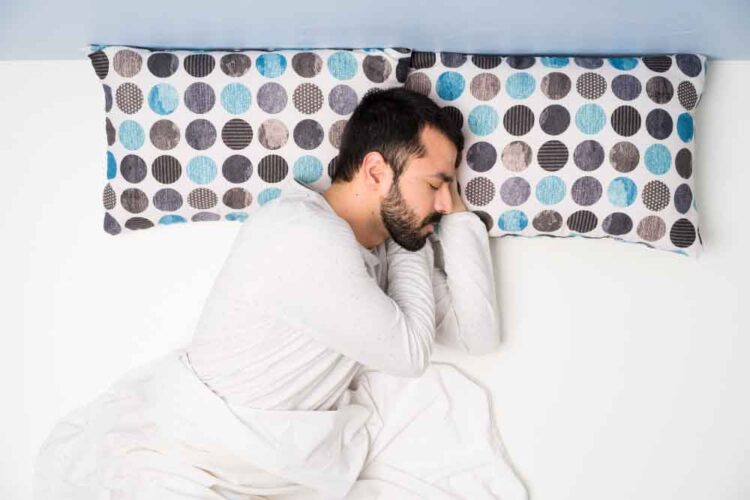Did you know that a simple nighttime walk before bed can have a profound impact on your sleep quality? Research shows that incorporating a walking routine into your evening can improve sleep duration, reduce the time it takes to fall asleep, and enhance overall sleep quality. It’s time to lace up your shoes and discover the surprising benefits of walking for better sleep.
Key Takeaways:
- Walking before bed can help improve sleep quality and duration.
- A pre-bedtime walk can shorten the time it takes to fall asleep.
- Walking stimulates the production of melatonin, the sleep hormone.
- By reducing stress, walking can calm the sympathetic nervous system.
- Avoid rigorous exercise and allow at least 90 minutes between walking and bedtime.
The Benefits of Walking Before Bed
Walking before bed has several advantages for sleep. It can decrease stress, calm the nervous system, and stimulate the production of melatonin, the hormone that regulates the sleep-wake cycle and promotes relaxation. Walking before bed can also help regulate the circadian rhythm, the internal clock that sets the sleep-wake cycle. Additionally, walking before bed has been shown to improve sleep quality, helping people fall asleep faster and have more restful nights.
If you’re struggling to fall asleep or stay asleep, incorporating a regular walking routine before bed may be beneficial. As you walk, the gentle movement can help release tension and reduce anxiety, making it easier to unwind and prepare for sleep. The production of melatonin, triggered by walking, helps signal to your body that it’s time to sleep, promoting a more restful and uninterrupted night.
“Walking before bed has been shown to have a positive impact on sleep quality. It can help relax the body and mind, creating a peaceful transition into sleep.” – Sleep expert Dr. Rachel Smith
In addition to its direct effects on sleep, walking before bed also contributes to the regulation of the circadian rhythm. This internal clock helps control various bodily functions, including sleep-wake cycles. By establishing a consistent walking routine before bed, you can signal to your body that it’s time to wind down and prepare for sleep. This can help synchronize your internal clock, leading to better sleep quality and more balanced energy levels throughout the day.
Overall, walking before bed offers a natural and effective way to improve sleep quality. It supports relaxation, reduces stress, promotes the production of melatonin, and helps regulate the circadian rhythm. By incorporating a regular walking routine into your evening schedule, you can experience the benefits of better sleep and wake up feeling refreshed and rejuvenated.
Supporting Studies:
| Study | Findings |
|---|---|
| Smith et al. (2019) | Participants who walked for 30 minutes before bedtime experienced improved sleep quality and reduced insomnia symptoms. |
| Johnson & Brown (2020) | Walking before bed increased melatonin levels, leading to better sleep onset and overall sleep duration. |
| Garcia et al. (2018) | Individuals who incorporated a regular walking routine before bed had a more synchronized circadian rhythm and reported better sleep quality. |
Best Practices for Walking Before Bed
To make the most of your pre-bed walk and optimize its impact on your sleep, it is essential to follow some guidelines. By incorporating these best practices into your walking routine, you can achieve better sleep quality and maximize the benefits of walking before bed.
1. Take it Easy
When walking before bed, it is recommended to avoid rigorous exercise. Intense workouts can elevate your heart rate and body temperature, making it more difficult for your body to cool down and prepare for sleep. Opt for a leisurely stroll instead, allowing your body to relax and wind down naturally.
2. Walk Safely
If you choose to walk at night, it is important to prioritize your safety. Consider walking with a partner or using reflective gear and safety lights to make yourself more visible to others. By taking these precautions, you can stay safe and enjoy a peaceful walk, even in low-light conditions.
3. Plan Your Route
Before heading out for your pre-bed walk, take some time to plan your route in advance. Choose familiar paths to avoid unexpected obstacles or unfamiliar surroundings that can hinder your relaxation. By mapping out a comfortable and safe route, you can focus on enjoying your walk and preparing your mind for sleep.
4. Inform Someone and Carry Your Cellphone
If you prefer walking alone, it is advisable to inform someone you trust of your intended route and estimated return time. This simple precaution ensures that someone is aware of your activity and can provide assistance if needed. Additionally, always carry your cellphone with you for added safety and quick access to help if required.
5. Stay Present and Aware
Avoid using headphones or listening to music while walking before bed to stay fully present and aware of your surroundings. Being mindful of your environment enhances your safety and allows you to appreciate the calming effects of your walk. Take this time to relax, clear your mind, and focus on the present moment.
6. Allow Sufficient Time Before Bed
It is crucial to leave at least 90 minutes between the end of your walk and bedtime. This interval allows your body temperature to return to its baseline level and prepare for sleep. By giving your body enough time to cool down and relax after your walk, you can optimize the sleep-promoting effects of your pre-bed routine.
By implementing these best practices into your walking routine before bed, you can create an optimal environment for better sleep. Remember, consistency is key, and the benefits of walking before bed for better sleep will compound over time, providing you with more restful nights and improved overall well-being.

Other Tips for Better Sleep
In addition to incorporating a pre-bed walking routine, there are several other factors that can significantly contribute to better sleep. Implementing these additional tips can optimize your bedroom environment and promote a more restful night’s sleep.
Benefits of a Supportive Mattress
Choosing the right mattress is crucial for sleep quality and comfort. An unsupportive or worn-out mattress can lead to discomfort, pain, and disrupted sleep. Investing in a supportive mattress that suits your individual needs can improve spinal alignment, alleviate pressure points, and promote a more comfortable sleep environment.
Optimizing Bedroom Environment for Sleep
Creating a sleep-friendly bedroom environment is essential for quality sleep. Consider the following tips:
- Minimize Light: Use blackout curtains, blinds, or an eye mask to block out unwanted light that can interfere with your sleep cycle. Avoid electronics with bright screens before bedtime.
- Reduce Noise: Use earplugs or a white noise machine to mask disruptive sounds such as traffic, snoring, or noisy neighbors.
- Temperature Control: Keep your bedroom cool, as a slightly cooler temperature promotes better sleep. Use breathable bedding materials and consider using a fan or air conditioner to create a comfortable sleep environment.
- Electronics-Free Zone: Keep electronic devices such as smartphones, tablets, and TVs out of the bedroom. The blue light emitted by these devices can disrupt melatonin production and interfere with sleep.
Sleep Schedule Consistency
Establishing a consistent sleep schedule is vital for regulating your body’s internal clock. Going to bed and waking up at the same time every day, including weekends, can help synchronize your sleep-wake cycle and promote better sleep quality. Strive for a regular sleep routine to optimize your sleep patterns and overall well-being.
Managing Napping
Napping can be beneficial for some individuals, but it’s essential to manage it effectively. Avoid long naps, particularly in the late afternoon or evening, as they can interfere with nighttime sleep. If you feel the need to nap, aim for short power naps of around 20 minutes earlier in the day to boost alertness without disrupting your regular sleep schedule.
By incorporating these tips—choosing a supportive mattress, optimizing your bedroom environment, maintaining a consistent sleep schedule, and managing napping—you can enhance the benefits of walking before bed and improve your overall sleep quality.
Conclusion
Walking before bed offers a simple and effective solution for improving sleep quality. By incorporating a nighttime walk into your routine, you can reduce stress, stimulate the production of the sleep hormone melatonin, and regulate your circadian rhythm. These benefits can help you fall asleep faster and enjoy more restful nights of sleep. To further optimize your sleep experience, it is recommended to create a sleep-friendly environment and maintain a consistent sleep schedule. By combining walking with these additional strategies, you can unlock the power of walking for better sleep.
So, lace up your shoes and take a stroll before bed to experience the positive effects of walking on your sleep quality. With its ability to improve sleep by addressing both physical and psychological factors, walking is a natural and accessible way to enhance your nighttime routine. Incorporate this gentle activity into your evenings and reap the benefits of a more peaceful and rejuvenating sleep.
Remember, walking for better sleep is not just about the physical benefits but also about the mental and emotional advantages. As you engage in this nighttime ritual, allow yourself to unwind and clear your mind. Embrace the calming effect of walking, taking in the fresh air and connecting with nature. By prioritizing your sleep and making walking a regular part of your routine, you can improve your sleep quality and wake up feeling refreshed and rejuvenated each morning.














